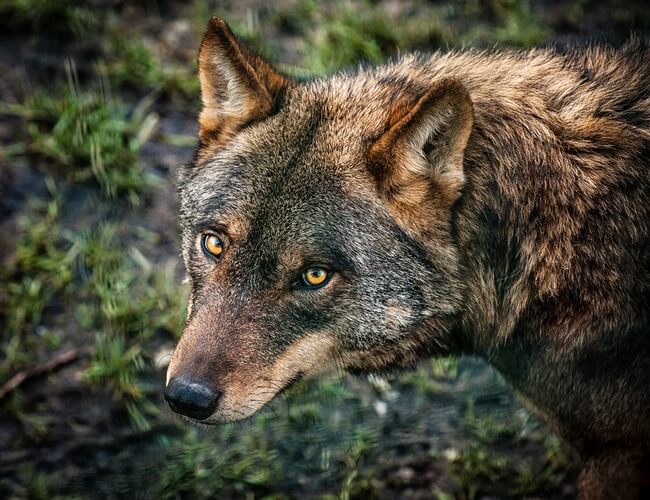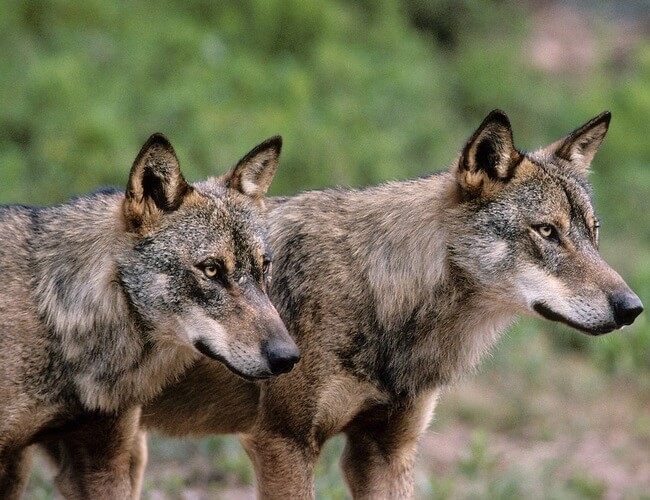
Iberian Wolf
The national animal of Portugal is the Iberian Wolf. Its scientific name is Canis lupus Signatus. It belongs to the family of Canidae a class of Mammalia and kingdom of Animalia. It is actually a subspecies of grey wolf that lives the forest and plains of northern Portugal and northwestern Spain.
This species of Iberian wolf varies in sense with other common Eurasian wolf with its lesser frame, white marks on the upper lips, the dark marks on the tail and a pair of dark marks in its front legs .
This differentiation has basically occurred due to the isolation of the Iberian Peninsula. The increase in glacier barriers in the Pyrenees and finally reached the Gulf of Biscay in the West and the Mediterranean in the East.
The weight of Males Iberian Wolf Animal can be 50 kg. And the weight of female species usually in between thirty and forty kilogram (30-40kg). The Portugal national animal Iberian wolf lives in small containers.
It has 4 toes on each back foot and five on the front. However neither front nor back reach the ground.
Each toe has a rounded non pull backing claw. Also it has a large heel type pad on each foot. It has long and tapered skull. Its large jaws help to hold the masseter (the lower jaw used in chewing) muscles.
The canines has largest 40 teeth are which can grow up to 5cm in length. It keeps the population of wild boar stable that’s why it is considered as valuable. Its diet ranging from small carnivores to rabbits, red deer, ibexes, roe deer and fishes. Even In some cases it eats domestic animals like sheep and dogs.
10 things Facts about Iberian wolf
- Iberian wolf is the most popular and native animal of Portugal country.
- Visitors from different countries and local of Portugal come and view the wolves from special observation towers.
- Due to its popularity and importance the people of the country educated about their protection and precaution with the help of volunteers.
- This kind of Wolf belongs to the largest member of the dog family.
- Mostly founds in grey color they can also vary in color from white to black.
- Unlike other animals they can also tolerate human proximity. Even they have to enter towns and villages usually in search of food.
- In Europe it occupies 100 and 500 square kilometers residential area .and live in groups of 2-7 animals.
- It can communicate by several ways which range from facial expressions to body language, roars, barks and howling.in order to keep separated group members in touch and increase social bonding.
- The breed process of wolves happened only once a year. Their sexual combination takes place in February or March.
- In the result of mating Pups (kids) of wolves born blind and deaf. Their eyes open after 10-13 days and they become capable of hearing after 21 days.
- With respect to diet they are meat eaters. They target animals such as rabbit, deer and even fish.
- Its how can be heard over a mile away.
- It lives in a mixture of woodland and scrub-land. Such environment provides them opportunities to hunt.
- Their life span is 6 to 8 years in wild and up to 16 in captivity.
- 4 to 7 cubs can be comprises usually from a litter.
- The Young species go away from the pack(group)) at 1-2 years old to find a mate and new territory.
- It is considered as official Portugal animal forever.
History of Iberian Wolf
White stripes on the snouts and black marks on the front legs are distinguishing markings of the subspecies.The majority living environment of Iberian wolf was Iberian Peninsula until 1900s.
However in 1950s and 1960s the Spain’s Francoist government started an annihilation movement and that leave the northwestern part of the country only remaining part wiped out.
in Portugal the Similar policies almost led to the loss of the animal south of the Douro river. On the other hand few authors claim it was sighted last time in 1930 in the South-Eastern Spanish .
Surprisingly a male wolf was found recently in Catalonia, where the last native wolf was killed in 1929.according to a submitted report in Sierra Morena the population was on the average of endangered. The same report shows that in the same year i.e. 2013 an estimated 300 individuals remain in Portugal.
Why is Iberian wolf the national animal of Portugal
Iberian wolf is basically a grey wolf that lives the forest and plains of northern Portugal . Visitors from different places and local of Portugal come and view the wolves from special observation towers.
Due to its popularity and importance the people of the country educated about their protection and precaution with the help of volunteers. There is special education and training center in Portugal.
These animals are human friendly in many environments. That’s why they have seen in the villages and town of Portugal in search of food without any fear. Due to all these facts it becomes officially the national animal of Portugal. This was a detail guide all about Iberian Wolf. Kindly do let us share your ideas about this great animal.
Also Check: National animal of New Zealand

